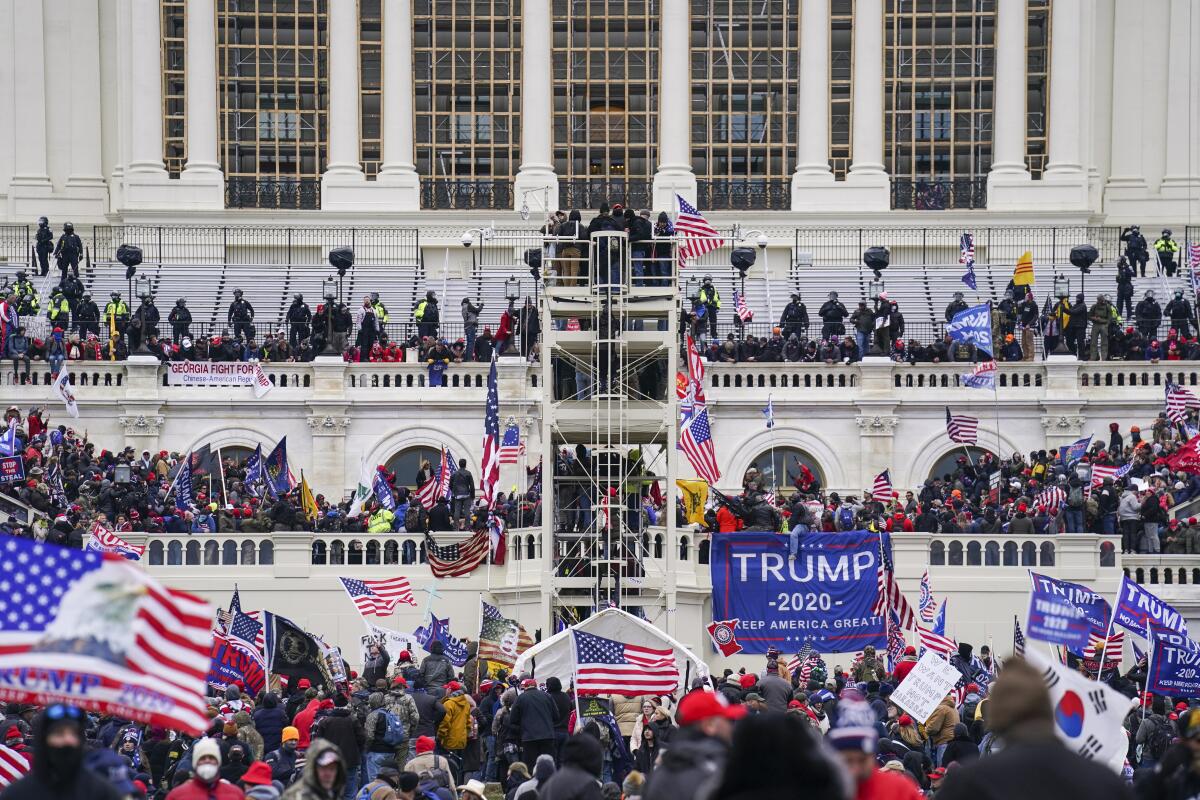Right-wing militia leaders, on trial for sedition, continue to threaten democracy

- Share via
WASHINGTON — Five leaders of the Oath Keepers, a right-wing militia that played a leading role in storming the Capitol on Jan. 6, 2021, went on trial last week in Washington.
The defendants, including Stewart Rhodes, the Yale-educated lawyer who founded the group, were charged with “seditious conspiracy”: plotting to attack the federal government by force to prevent Congress from certifying the 2020 presidential election.
Prosecutors said Rhodes and others planned the assault on the Capitol, ordered their troops to bring “zombie killer tomahawks” and other weapons and stockpiled guns in hotels in case the battle escalated.
America’s pattern of calcified politics makes for repeated high-stakes elections fought in apocalyptic tones, with neither party willing to yield an inch.
“We aren’t getting through this without a civil war,” Rhodes told his followers in a text message, according to his indictment.
The trial, the first of several planned for ringleaders of the insurrection, has high stakes.
It’s the highest-profile prosecution so far in the Justice Department’s massive Jan. 6 dragnet.
It’s a rare use of “seditious conspiracy,” the U.S. equivalent of a domestic terrorism law, a charge that dates back to the Civil War. The defendants aren’t accused of committing violent acts but of organizing the squad that did.
And it may have crippled the Oath Keepers, a 13-year-old militia recruited largely from military veterans and law enforcement officers that styled itself as the armed vanguard of the militant right.
“As an organization, the Oath Keepers have lost a lot of steam from this,” said Jon Lewis, a terrorism scholar at George Washington University. “Members have distanced themselves from the leadership. Their brand has become toxic.”
But the prosecutions haven’t put a perceptible dent in the larger phenomenon of right-wing extremism, an ecosystem that includes white supremacists, antigovernment militants and many (but far from all) supporters of former President Trump.
For example, the Proud Boys, another militia whose leader, Enrique Tarrio, and four lieutenants are scheduled to go on trial on similar charges in December. The Proud Boys aren’t shrinking; they appear to be expanding.
“Their leadership has been decimated, but we’ve seen increased activity at a local level,” Oren Segal of the Anti-Defamation League told me. “They keep adding new chapters ... and their agenda has diversified; they’re showing up at school board meetings and campaigning on LGBTQ issues.”
The militant right has survived Jan. 6 in other forms too.
“It’s a mistake to focus on the militias,” said Robert Pape of the University of Chicago, who has studied the Jan. 6 rioters.
“Almost 90% of the Jan. 6 defendants were not militia members,” he said. “What made Jan. 6 happen was not Oath Keepers or Proud Boys. It was a larger movement that includes many mainstream Trump supporters too. ... The militias are only the most visible part.”
Based on public opinion surveys, about 18 million Americans believe violence is justified to restore Trump to the White House, Pape estimates. Other polls have suggested even larger numbers.
Terrorism scholars say the extremist right is surviving not on the strength of its organizations but on a powerful narrative that appeals to millions of discontented conservatives.
A key part of that narrative is the conviction, fed by Trump and his allies, that Democrats stole the 2020 election and will continue using illegitimate means to prevent conservatives from winning.
Now add one more phenomenon, something scholars call “stochastic terrorism”: seemingly random, lone-wolf attacks inspired by the statements of leaders like Trump.
“We have people with massive megaphones saying we need to do something to stop a corrupt FBI, or an Internal Revenue Service that’s about to send 87,000 armed agents into your homes,” said Lewis, referring to the plan to hire 87,000 IRS employees, most of whom will not be enforcement agents.
“Some people’s response to those messages is not ‘I should go vote.’ It’s ‘I should pick up my gun and head for the nearest federal building.’”
If Republican leaders, including Trump, don’t intend that to be the effect of their words, there’s a simple remedy: They could denounce violence in all its forms — including the violence of Trump supporters on Jan. 6.
Too often, they don’t.
Their political winking at violence makes a difficult task — fighting domestic terrorism while respecting civil liberties — even harder.
“It’s impossible for law enforcement to chase down every right-wing extremist who posts messages on the internet and also owns a firearm,” said Lewis.
All of which means this wave of violent extremism on the right is far from over.
Before the 2020 presidential election, Trump was asked what his message was for the Proud Boys, who even then were issuing threats of violence.
His answer was indulgent. “Stand back and stand by,” he said.
As congressional elections approach next month, and a presidential campaign soon after, they are standing by again.
More to Read
Get the L.A. Times Politics newsletter
Deeply reported insights into legislation, politics and policy from Sacramento, Washington and beyond. In your inbox twice per week.
You may occasionally receive promotional content from the Los Angeles Times.












